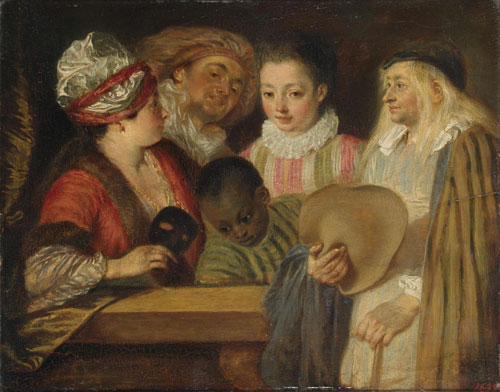
- Home Page
- Accepted
Paintings & Copies - Doubtful
Attributions - Doubtful Textual References
- Alternative
Titles - Collectors &
Museums - Bibliography
- Search Abecedario
- Watteau &
His Circle
X. Cinq personnages occupés à faire de la musique
Entered September 2020

Whereabouts unknown
Material unknown
Measurements unknown
PROVENANCE
Paris, with Pierre Grand-Pré (painting dealer). His sale, Feb 16, 1809, lot 40: “PAR LE MÊME [WATTEAU (ANTOINE)]. Un petit Tableau très-curieux dans le genre d’imitation du Titien. Il représente cinq Personnages vus à mi-corps, occupés à faire de la musique. Un coloris chaud et infiniment d’esprit dans les caractères des têtes, présentent une étude précieuse du Maître.” Sold for 150 livres to Coulon [sic for Denon].
Paris, collection of Dominique Vivant, baron Denon (1747-1825; artist, diplomat, first director of the Musée du Louvre). His sale, Paris, January 15ff, 1827, cat. 189: “PAR LE MÊME. [WATTEAU (Antoine)] . . . Précieux tableau où ce peintre a voulu imiter le Giorgion. Trois jeunes musiciens sont dirigés par un professeur, qui indique le mesure; une jeune et jolie femme, qui les écoute avec attention, complète la composition. Les figures sont vues à mi-corps. Ce tableau soutiendrait la comparaison avec un tableau vénitien. L. 11 pouces.— H. 8 pouces. B.”
REMARKS

Were it not that both descriptions make it clear that there were five half-length figures, one might think that the painting in question was Watteau’s Du Bel âge. That picture included four people: a young man conducting the ensemble, and three singers—two men and a woman. But the painting under consideration here had five people: a conductor, three musicians (singers or instrumentalists) and a woman listening to the ensemble.

Giorgione or Titian, The Concert, c. 1510-15, oil on canvas, 86.5 x 123.5 cm. Florence, Uffizi.
The compositional format of Du Bel âge—half-length figures compressed into a narrow space—is one that became popular in the Renaissance. The 1809 Grand-Pré catalogue proposed an analogy with Titian, whereas the 1826 catalogue of the Denon sale named Giorgione as a source of inspiration. In both instances, the commentators could have been referring to paintings such as the Uffizi’s The Concert, a work whose attribution over the centuries has gone back and forth between Titian and Giorgione. But there are other possible sources in Venetian art, as well as in Flemish sixteenth-century pictures. Equally, one could turn to Caravaggesque painting, both Italian and Northern. Watteau (or whoever painted this picture) was working in a well-established mode.

Watteau, Coquettes, qui pour voir, oil on panel, 19 x 24 cm. St. Petersburg, Hermitage Museum.

Watteau, Arlequin, Pierrot, Scapin, oil on panel, 18.6 x 23.8 cm. Waddesdon, Waddesdon Manor.
Watteau was fond of creating half-length compositions, such as Coquettes, qui pour voir and Arlequin, Pierrot, Scapin. Whereas Philippe Mercier utilized this format on many occasions, curiously, it was avoided by Pater and Lancret.